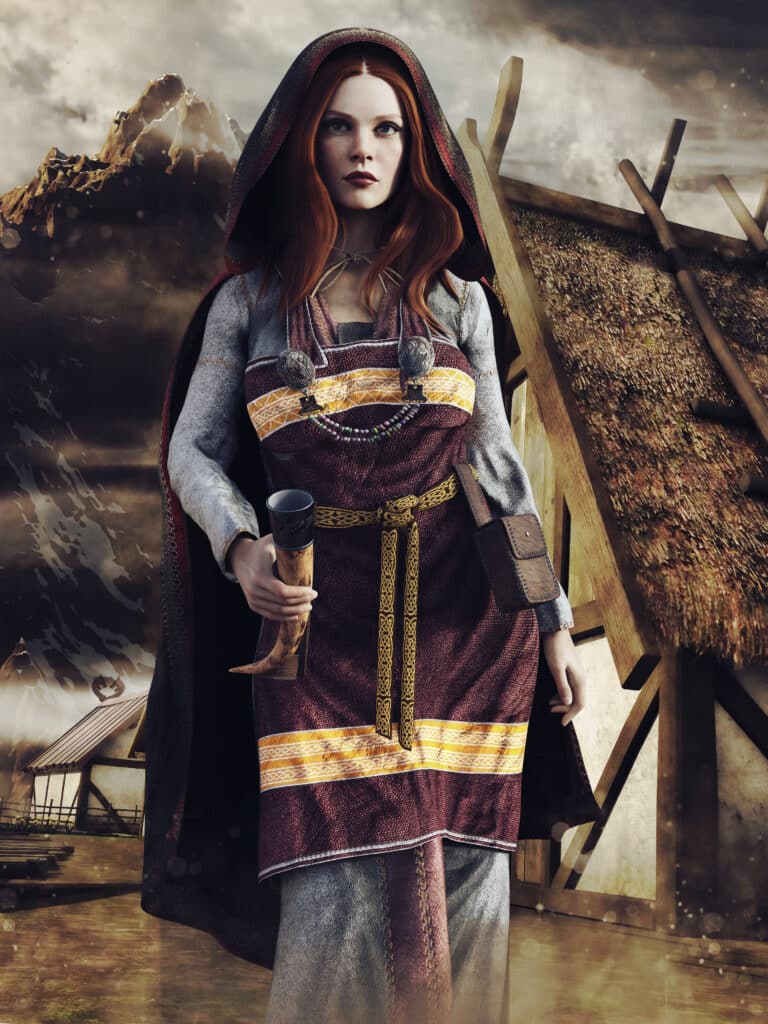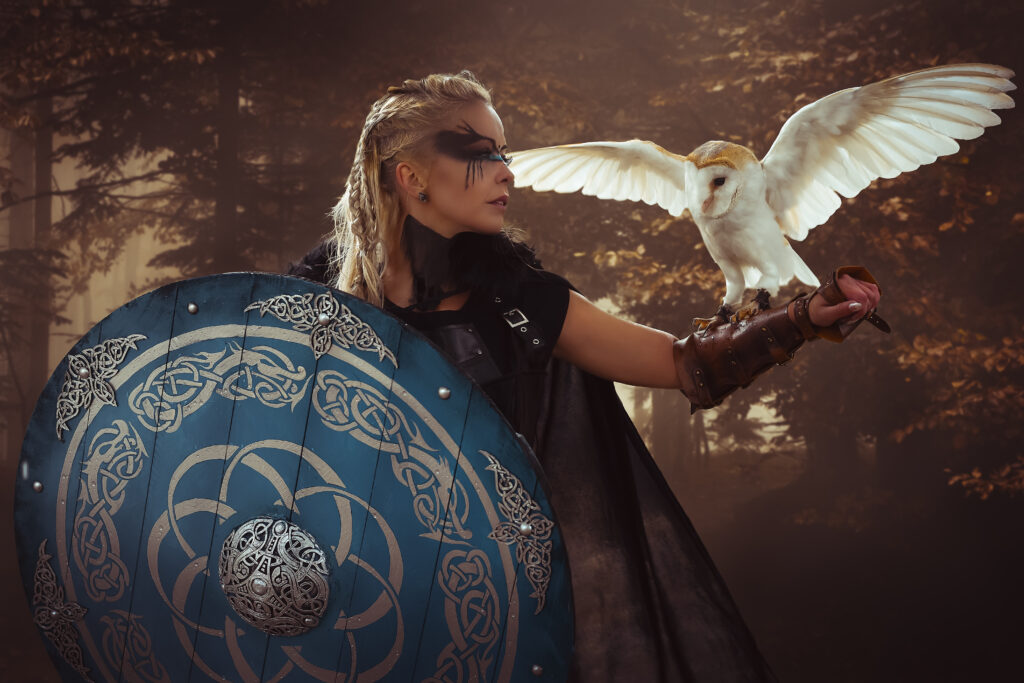Were Shieldmaidens Real: The Role of Women in the Viking Age

The Vikings have remained a popular topic of interest for the past millennia. Although we have learned far more about their culture in the past century, there still persists an imagine of savagery. To anyone who has learned of Viking culture via television and film, this imagery of fierce warriors who spend most of their time pillaging villages and taking slaves back to Scandinavia dominates the narrative. The idea of the shield-maiden has also become popular in recent years. This post will examine whether or not shieldmaidens were real and fought in Viking battles.
In the popular television series Vikings, which has since come to a close, the world was given Queen Lagertha, a shield-maiden. She was an equal among men who fought in battle alongside male warriors. But were Viking shieldmaidens real? This is a loaded question. Inevitably I think if you look hard enough you can prove that almost anything is possible, and has occurred in exceptional circumstances. In this case, yes, there have been a number of finds that indicate women did indeed fight in battle. However, I think it’s a stretch to say that shieldmaidens were common, or that women were even prepared to defend themselves at home.
Seek and Ye Shall Find
Something that commonly occurs when researching anything is a confirmation bias. Anyone who googles “shieldmaiden” will no doubt find scholarly articles about the Birka find. This grave unearthed what has been confirmed as a female, who was buried with weapons indicating she was a fighting warrior. But this is where I interject the logic of this being the exception, and not the rule.
Layout

I’m going to take you through the Birka find and tell you what is so exceptional about this find. In this case, it certainly seems that shield-maidens were real. Then we will also look at a few more finds taken from a Masters thesis at the University of Iceland that sheds light on some women who may have been fighters. Sprinkled throughout this will be some information about the well-known roles of women throughout the Viking Age.
The neat thing about history is that we never really know for sure what happened. So much is left to interpretation, and so much constantly changes as we discover and learn more from the past. I think the exciting thing about the Birka find was that many scholars heralded this as precedent for future findings to support the idea of women warriors. That is absolutely possible. But what I think we have now, is limited information to support the idea that shieldmaidens were a common sight.
A More Likely Scenario
What is more likely, is that a few exceptional women rose to power, probably after marrying into extreme power, and perhaps holding that power after the death of their husband. Or I suppose an extremely capable woman, who had an opportunity to demonstrate prowess, continued on the journey of fighting in some capacity and was recognized as a warrior. I would imagine this as being a woman skilled in strategic military tactics, helping to plan flanking on a battle field. It might also look like a woman who was an exceptional archer, and brought along because she never missed. I think Viking Age men who recognize the value of a capable woman, but I don’t imagine them recruiting them the way they did young men to go Viking seasonally and raid.
Why is the Shield-Maiden so Appealing?

So let’s quickly check out where this idea came from. The show Vikings skyrocketed to popularity about a decade ago, and it blends some pop culture desires, with a bit of historical accuracy, and a large dash of the fantastical. But it’s cool. It’s just as cool as other fantasy shows out there, but this one grips us because we kind of say “wow, they really existed”.
In this show we are introduced to Lagertha, the first wife of Ragnar Lothbrok. Now this guy was real, though there is obviously some creative license used throughout the series. There is a Saga of Ragnar Lothbork (sometimes spelled Ragnar Lodbrok), called Ragnars saga Loðbrókar. This is a 13th-century Icelandic legendary saga. His wife Lagertha is not actually mentioned in this saga. We first see her name in Saxo Grammaticus’s Gesta Danorum, or “Deeds of the Danes”. This was a Latin work, also composed in the 13th-century.
This is also thought to be based on lengendary tales, and therefore the history of Lagertha is not too reliable. She is definitely the character that peaked interest in the idea of the shieldmaiden.
The Birka Female Viking Grave

Let’s take a look at the very popular Birka find from Birka, Sweden. This lady has become the poster child and confirmation bias champion of the shieldmaiden argument. So this grave was excavated in 1878 and it was assumed right away to be a mans grave. The grave was furnished with all the accoutrements of an elite Viking warrior. They were buried in the 10th century which is kind of the peak Viking Age expansion era. They were moving all around Europe during this period and causing lots of trouble.
DNA Proved She’s a Female
In 2017, however, osteological analysis (studying bones and stuff) as well as DNA proved that this burial was actually a woman! That kind of blew everyone’s minds, because this had been celebrated as a perfect example of a burial site for a high ranking Viking warrior. But…it’s a woman? That was big news in the historical and archaeological worlds. The world still doesn’t want to accept that women could be fierce warriors who led men into battle, so after evidence proved this was a woman there was a little push back from the academic community. In the 130 year time period between when the grave was found and the DNA analysis stating it’s a woman there were over 50 academic papers published totally agreeing that this was a grave of a high ranking warrior.

The minute we found out it was a woman, some academics started back peddling on that and were like “opps, nope..she must have been sewing and fell into a fancy grave”. Ok, that’s not true. But they did publish papers arguing that she was maybe just the wife of a high ranking Viking and was buried with these materials to show a great deal of respect. Either way, people weren’t having it, that this was the grave of a shieldmaiden.
Women Warriors Throughout History
This isn’t the only example of women being involved in battles and fighting. Ancient Greek sources tell of the Sauromatae, who were descendants of the ancient Scythians. They spoke about their women hunting and fishing alongside the man of the community. Archaeological digs from this area did uncover female skeletal remains that showed signs of women having battle wounds. They were also buried with bronze tipped arrows, and their legs showed signs of being bow-legged which indicated they were horse-mounted often. These Scythian warrior women were thought to have been horse mounted archers, who assisted in battles, but from the safety of the backlines.

Female Ship Captains from Ancient Persia
In the ancient war between Greece and Persia there exists a tale of Artemisia I of Caria who commanded a fleet of five ships for the Persians. She was respected for her intelligence and cunning and became a trusted military advisor. She led an army without obligation, which impressed both the Persian’s and the Greeks.

The Feudal Period in Japan
There are also tales of a female samurai in the 12-14th century sometime named Onna-Bugeisha. They were not expected to partake in the fighting the way men would be obligated, but they were trained to fight in order to take care of the homestead when men were away. In this instance, they were equipped with a Naginata, a polearm weapon, and protected the home. This is likely an example of how many females became known for their fighting.
The Role of Viking Women
Viking women would also likely have known some defensive moves to protect themselves, their children, and their farms. When men were away campaigning or (Viking) as the term is properly used, they would be left to defend their homestead. This could be extremely dangerous as people would typically know in these small areas that men might be away from spring until fall, or perhaps for a year or two entirely. Viking women also align themselves closely with mythical females who possess great power. In Norse mythology there are a number of female deities who are known for their fierce nature. We have Freya who rides her chariot of cats into battle (For more on the importance of Norse Cats, check out this post on Viking Kitties). We also have the seeresses, and the Norns, who are tied to fate, and were held in great esteem during the Viking period.
During the Viking Age when the Danes were trying to establish territory in Anglo-Saxon lands. Here we also read of Aethelflaed, the daughter of Alfred the Great of Wessex who fought the Danes until her death. There are many individual tales of women being exceptional fighters throughout history. But as I stated earlier I think this is the exception and not the rule.
Women Want to Break Barriers
I wholeheartedly believe that women participated in battle at times. In theory that means shield-maidens were absolutely real. I think that history had fiery women, just like we have today, who want to break barriers. When I worked on the oil rigs in Northern Alberta (as a medic), there was always a myth travelling around that there was an “all female rig”.
Now, in my experience, the women usually worked in the campsites for the rigs. We cleaned, cooked, did the housekeeping, were trained as medics, and maybe even drivers. But 15-16 years ago in the early 2000’s I didn’t know of any female drillers. I really don’t think there was an entire rig of them. This is an example of women wanting to break through. It might also say something about the men finding some entertainment in the idea of “Sisters in the Brotherhood”. That title is actually from a book I read back in 2014ish. It highlighted women breaking into industries typically thought to be the realm of men. I believe it focused itself in America, with women breaking into firefighting, and coal mining.
Concluding Thoughts
I come from a mining town in Canada. When the mines closed around the year 2000, there had been no women who worked in them. The idea that there are domestic roles is not something to be found in the distant past. We still ascribe greatly to the idea of gendered roles. Men were more typically the fighters and the defenders, and the providers. But there have always been women who wanted to push these boundaries, and clearly they sometimes succeeded.
I do not think that shield-maidens were the norm. I absolutely believe that there were few exceptional women who proved themselves capable in battle. Those women were likely honoured with a warriors burial. This means that shield-maidens were real and did probably exist. They just did not exist in the numbers we are led to believe at times.

